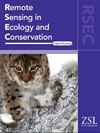利用空间捕获-再捕获模型,游客目击提高了相机陷阱衍生密度估计的精度
IF 4.3
2区 环境科学与生态学
Q1 ECOLOGY
引用次数: 0
摘要
空间捕获-再捕获(SCR)为动物个体可识别的可靠种群估计提供了黄金标准。大型食肉动物的抽样通常在短时间内进行,以满足种群关闭的假设。由于大型食肉动物通常是难以捉摸的,并且密度很低,因此调查通常会导致捕获的独特个体数量较少,并且重新捕获的空间有限,这可能导致收敛和参数可识别性问题。在旅游客流量高的地区,游客可以提供额外的空间捕获信息。我们用多时段SCR模型中的游客目击数据补充了基于相机陷阱的豹(Panthera pardus)监测项目的个体遭遇历史数据;我们评估了组合多个数据源的好处。整合游客观测数据提高了估算的精度(一半相对置信区间宽度:组合= 23.1%),从而估算出每100平方公里7.02只豹的总密度(95% CI: 5.59-8.84 / 100平方公里)。游客衍生的方法比相机陷阱便宜92.5%,突出了在高旅游活动地区用这种数据来源补充相机陷阱调查的成本效益。该研究表明,与单独使用任何一种方法相比,将来自相机陷阱的结构化调查数据与非结构化游客图像相结合,可以提高最终的密度估计。在旅游活动频繁的地区用游客图像补充结构化相机捕获数据,可以通过增加采样的空间和时间覆盖,以有限的额外成本和提高密度估计的精度,提高可扩展性。为了进一步提高这些方法的可靠性,我们提出了改进公民科学报告以整合到SCR框架中的建议。本文章由计算机程序翻译,如有差异,请以英文原文为准。
Tourist sightings improve the precision of camera trap‐derived density estimates using spatial capture‐recapture models
Spatial capture‐recapture (SCR) provides the gold standard for robust population estimates where animals are individually identifiable. Sampling for large carnivores is often conducted over short timeframes to meet assumptions of population closure. As large carnivores are often elusive and found at low densities, surveys often result in low numbers of unique individuals captured and limited spatial recaptures, which can lead to convergence and parameter identifiability issues. In areas of high tourism footfall, additional spatial capture information can be provided by tourists. We supplemented individual encounter history data from a camera trap‐based monitoring programme for leopards (Panthera pardus ) with tourist sighting data within multi‐session SCR models; we evaluated the benefits of combining multiple data sources. Integrating tourist observations improved the precision of estimates (Half Relative Confidence Interval Width: Combined = 23.1%), resulting in an overall density estimate of 7.02 leopards per 100 km2 (95% CI: 5.59–8.84 per 100 km2 ). Tourist‐derived methods were 92.5% cheaper than camera trapping, highlighting the cost‐efficiency of supplementing camera trap surveys with this source of data in areas with high tourism activity. This study demonstrates that combining structured survey data from camera traps with unstructured tourist‐derived images improves resultant density estimates compared to using either method alone. Supplementing structured camera trapping data with tourist images in areas of high tourism activity can offer improvements in scalability by increasing spatial and temporal coverage of sampling, with limited additional costs and improved precision in density estimates. To further enhance the reliability of these methods, we provide recommendations for improving citizen science reporting for integration into SCR frameworks.
求助全文
通过发布文献求助,成功后即可免费获取论文全文。
去求助
来源期刊

Remote Sensing in Ecology and Conservation
Earth and Planetary Sciences-Computers in Earth Sciences
CiteScore
9.80
自引率
5.50%
发文量
69
审稿时长
18 weeks
期刊介绍:
emote Sensing in Ecology and Conservation provides a forum for rapid, peer-reviewed publication of novel, multidisciplinary research at the interface between remote sensing science and ecology and conservation. The journal prioritizes findings that advance the scientific basis of ecology and conservation, promoting the development of remote-sensing based methods relevant to the management of land use and biological systems at all levels, from populations and species to ecosystems and biomes. The journal defines remote sensing in its broadest sense, including data acquisition by hand-held and fixed ground-based sensors, such as camera traps and acoustic recorders, and sensors on airplanes and satellites. The intended journal’s audience includes ecologists, conservation scientists, policy makers, managers of terrestrial and aquatic systems, remote sensing scientists, and students.
Remote Sensing in Ecology and Conservation is a fully open access journal from Wiley and the Zoological Society of London. Remote sensing has enormous potential as to provide information on the state of, and pressures on, biological diversity and ecosystem services, at multiple spatial and temporal scales. This new publication provides a forum for multidisciplinary research in remote sensing science, ecological research and conservation science.
 求助内容:
求助内容: 应助结果提醒方式:
应助结果提醒方式:


